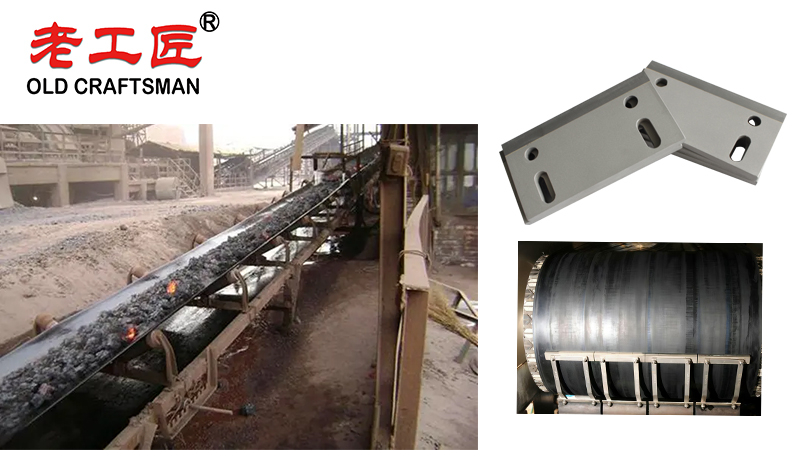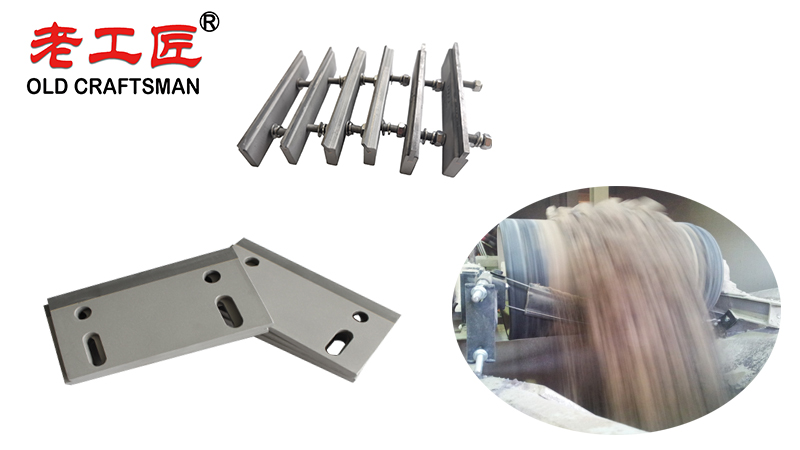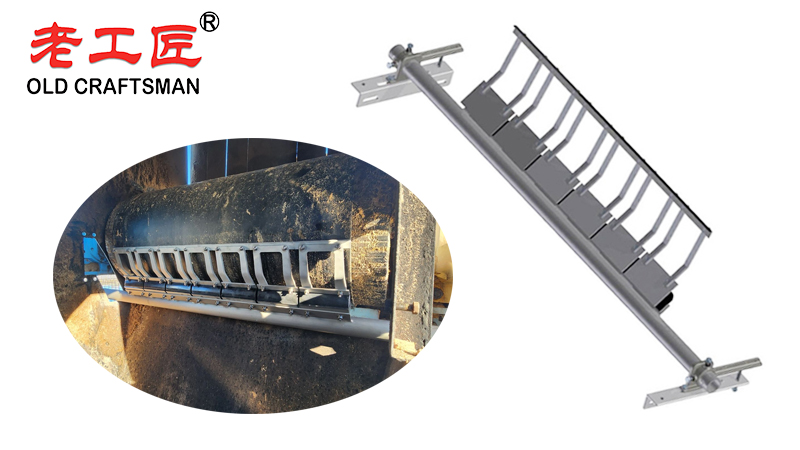Here is a detailed explanation of how secondary tungsten carbide scrapers boost conveyor belt system operational efficiency, structured for clarity and impact.

Executive Summary
Secondary tungsten carbide scrapers are a critical, high-performance component in modern conveyor belt systems. Positioned after the primary cleaner, they act as a final defense against material carryback. By utilizing the extreme hardness and wear resistance of tungsten carbide, these scrapers significantly enhance operational efficiency by reducing downtime, lowering maintenance costs, preventing belt damage, improving safety, and minimizing material loss. This translates directly into higher profitability and system reliability.
The Problem: Conveyor Belt Carryback
Carryback is the residual material that adheres to a conveyor belt after it passes over the head pulley and discharges its primary load. This material, often fine, wet, or sticky (like clay, limestone, or coal slurry), accumulates on the belt’s return side, leading to a cascade of operational inefficiencies:
- Belt Mistracking: Uneven material buildup causes the belt to drift off its intended path.
- Roller and Idler Damage: Accumulated material hardens, creating a rough surface that accelerates wear on return rollers and idlers.
- Structural Damage: Falling carryback creates piles of material underneath the conveyor, which can bury and damage the structure, pulleys, and other components.
- Safety Hazards: Spillage creates slip-and-fall risks and can be a dust generation point, leading to respiratory issues and potential combustion risks.
- Increased Labor Costs: Manual cleanup of spilled material is constant, labor-intensive, and expensive.
The Solution: Secondary Tungsten Carbide Scrapers
A primary cleaner (often made of polyurethane) does the initial bulk removal. The secondary scraper is the precision tool designed to remove the stubborn, thin layer of material that the primary cleaner misses.
Why Tungsten Carbide?
Tungsten carbide is a composite material known for its exceptional properties:
- Extreme Hardness: It is one of the hardest materials available, significantly harder than the abrasive silica and minerals found in most bulk materials. On the Mohs scale, it ranks around 9 (diamonds are 10).
- Superior Wear Resistance: It outlasts traditional scraper materials like steel or polyurethane by orders of magnitude, often lasting 5-10 times longer.
- Maintained Sharp Edge: Unlike softer materials that blunt and become less effective, tungsten carbide blades maintain a sharp scraping edge throughout their lifespan.

How Secondary Tungsten Carbide Scrapers Boost Operational Efficiency
1. Dramatic Reduction in Downtime
- Longer Service Intervals: Tungsten carbide scrapers can operate for months, or even years, without needing replacement. This eliminates frequent shutdowns required to change out worn steel or polyurethane blades.
- Less Unplanned Stoppages: By effectively controlling carryback, they prevent the spillage that leads to belt mistracking and roller jams, which cause unexpected production halts.
2. Substantial Reduction in Maintenance Costs
- Lower Parts Consumption: The incredible wear resistance means far fewer scraper blades need to be purchased and stocked over the life of the conveyor.
- Reduced Component Wear: By keeping the return side of the belt clean, the scraper protects expensive downstream components like return idlers, rollers, and pulleys from premature abrasive wear.
- Elimination of Cleanup Labor: Automated, effective cleaning drastically reduces or even eliminates the need for manual cleanup crews, saving significant labor hours.
3. Extended Belt Life
- Prevents Belt Damage: A clean return belt prevents material from being dragged into the tail pulley, where it can become trapped and gouge or rip the belt carcass.
- Reduces Tracking Stress: A clean belt tracks truer, reducing edge wear and the stress on belt splices.
4. Enhanced Safety and Environmental Compliance
- Eliminates Slip Hazards: By preventing material spillage, the risk of slip-and-fall accidents for personnel working around the conveyor is massively reduced.
- Controls Dust: Wet carryback dries and becomes airborne dust. Effective scraping at the source is a primary method of dust control, improving air quality and helping operations meet stringent health, safety, and environmental (HSE) regulations.
5. Maximized Material Yield and Reduced Loss
- Recovers Valuable Product: In applications handling valuable commodities (e.g., copper ore, grain, fertilizers), the secondary scraper recovers product that would otherwise be lost as waste. This directly increases revenue and reduces raw material costs.
- Reduces Waste Disposal: Less spillage means less waste material to handle and dispose of, lowering associated costs.
Key Considerations for Optimal Efficiency
To maximize the benefits of a secondary tungsten carbide scraper, proper selection and maintenance are crucial:
- Correct Installation and Tension: The scraper must be installed at the correct angle and with the proper blade tension against the belt. Too little pressure is ineffective; too much can cause premature belt wear.
- Blade Design: Blades are often segmented to accommodate belt curvature and imperfections, ensuring consistent contact across the entire belt width.
- Belt Condition: While effective, a tungsten carbide blade requires a belt in good condition. Severe gouges or damaged splices can snag on the rigid blade.
- System Integration: It should be part of a comprehensive cleaning system that includes a primary cleaner and possibly a conditioner (like a water spray system for very sticky materials).

The mining conveyor belt scraper in a heavy-duty bulk material belt system must withstand extreme conditions, including abrasion from ore and coal, high temperature environments in processing plants, and constant chemical exposure from dust suppressants or leaching agents. To ensure long-term performance and minimize downtime, the scraper is typically manufactured from advanced carbon fiber reinforced polymer (CFRP) or other high-performance reinforced plastic composites.
These materials offer an exceptional strength-to-weight ratio, outstanding chemical resistance, and superior heat resistant properties compared to traditional rubber or polyurethane blades. During tensile testing, the stress-strain curve of CFRP clearly demonstrates a wide elastic region with very high tensile strength, allowing the scraper to flex under impact yet return to its original shape without permanent deformation (plastic deformation occurs only at extremely high loads, far beyond normal operating conditions).
The excellent mechanical properties of carbon fiber reinforced polymer also make it ideal for critical components in roller conveyors and the overall conveyor system, where lightweight, corrosion-resistant, and thermally stable materials significantly extend service life while reducing energy consumption and maintenance costs in harsh mining environments.
Conclusion
Investing in a high-quality secondary tungsten carbide scraper is not merely a maintenance purchase; it is a strategic investment in operational efficiency. The upfront cost is quickly offset by the substantial and continuous savings from reduced downtime, lower maintenance labor and parts costs, extended equipment life, improved safety, and increased material yield. For any operation reliant on conveyor belts, it is one of the highest-return upgrades available.
“Zhuzhou Old Craftsman Precision Alloy Co., Ltd. could make tungsten carbide wear parts and make your equipment use life is tens of times longer than before! We specialize in providing customized carbide wear products solutions to meet the demanding requirements of industries such as aerospace, automotive, mining, and precision machining.”
Belt scraper Brazing brazingprocess CARBDIE HAMMER carbide Carbide belt scraper carbidebrazing carbide hammer Crusher CRUSHER HAMMER Informational Internal stress metal mining Refractory Brick Mold Secondary belt cleaner scraper stresses VSI crusher wear plates welding